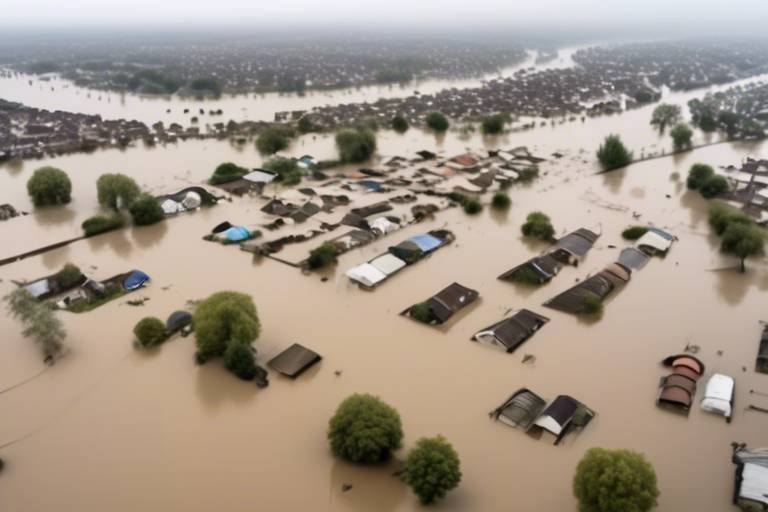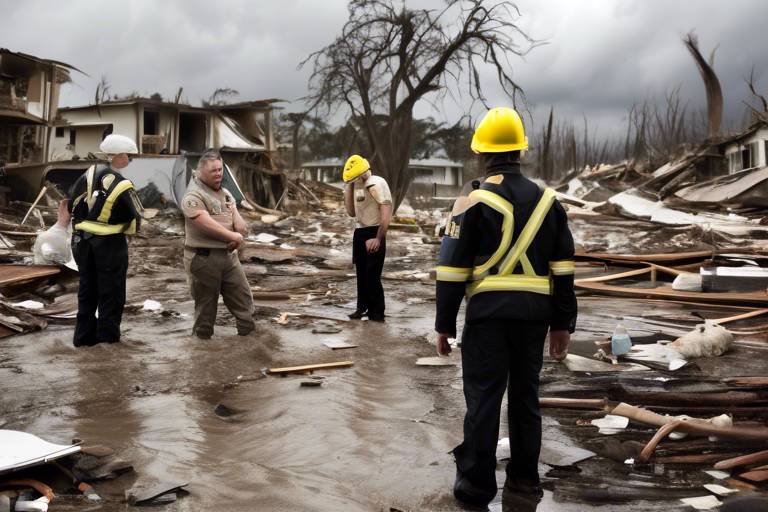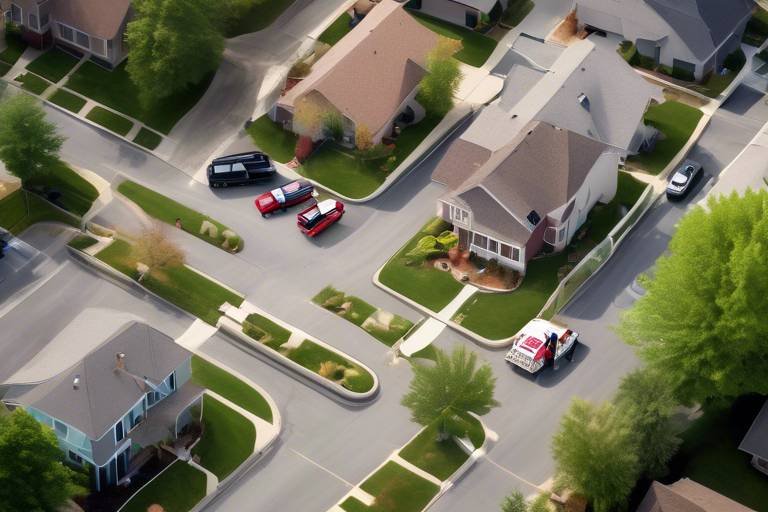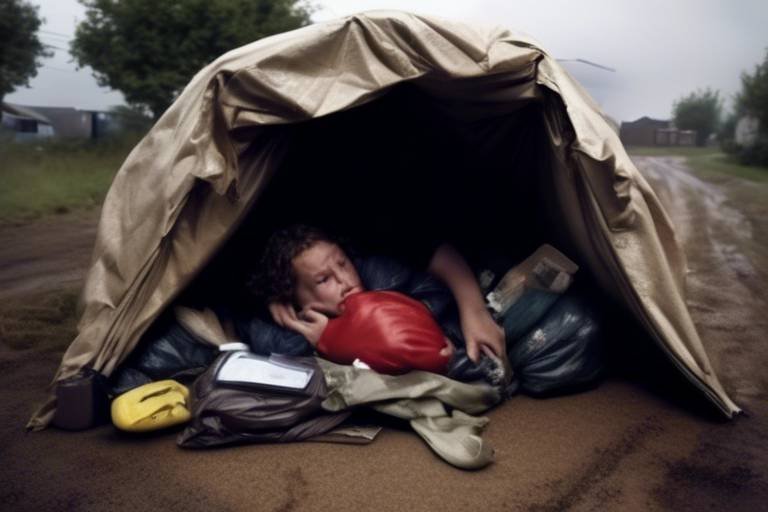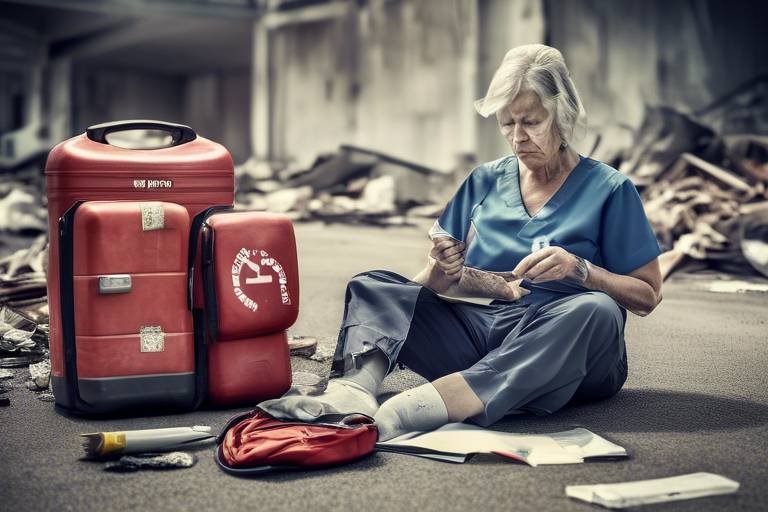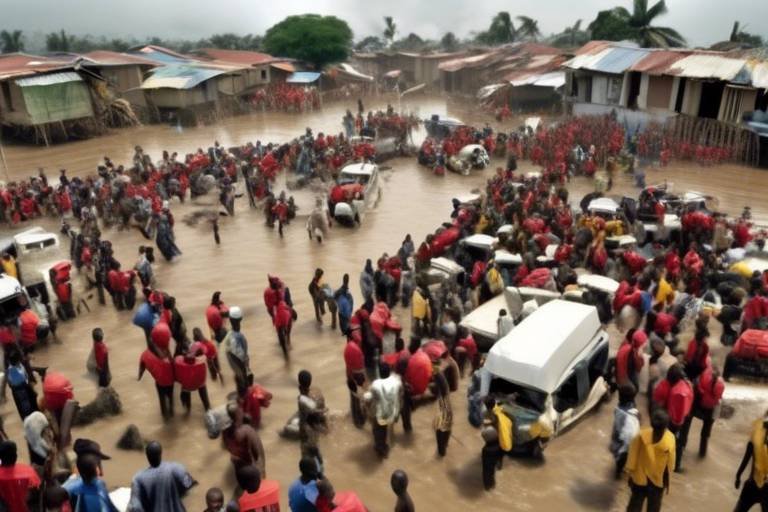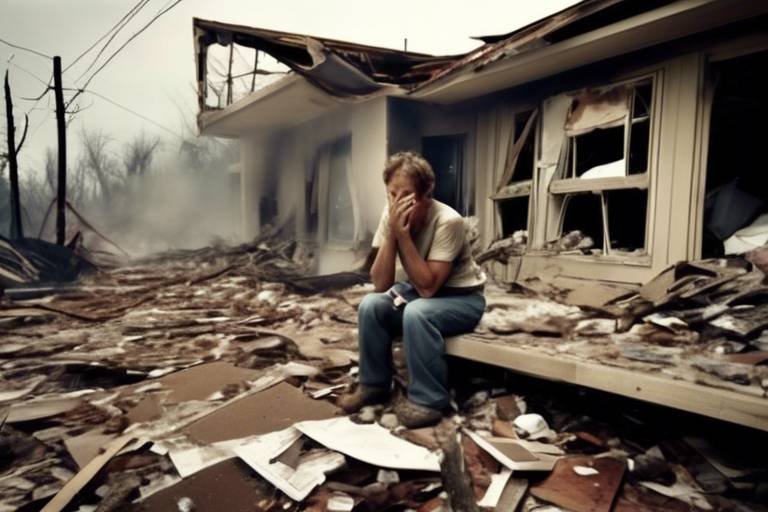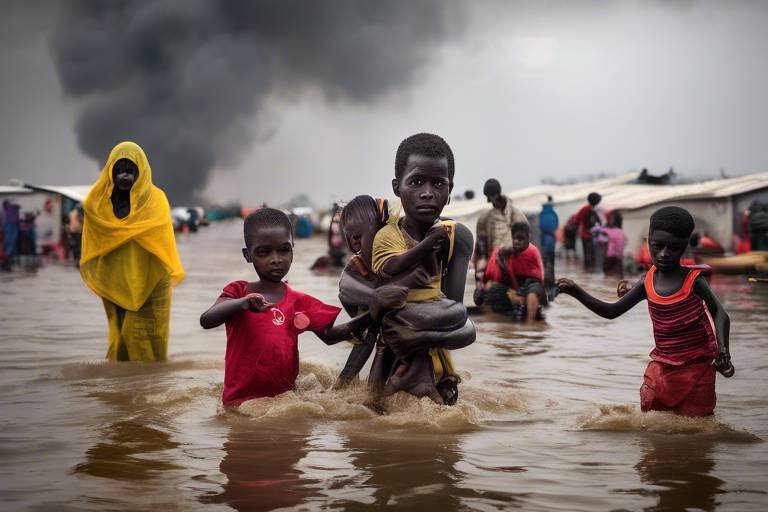The Importance of Advance Preparations for Floods
Floods can strike with little to no warning, transforming peaceful neighborhoods into chaotic disaster zones in a matter of hours. The reality is, when it comes to natural disasters like floods, **advance preparations** are not just helpful; they can be the difference between safety and tragedy. Imagine waking up to find your home surrounded by water, with no plan in place to protect your family or belongings. It's a nightmare scenario that can be avoided with the right strategies in place.
In this article, we will delve into the critical need for advance preparations in mitigating the impact of floods. By understanding the risks, creating emergency plans, fostering community involvement, and utilizing technology, we can significantly enhance our resilience against this natural threat. Let's face it, floods are unpredictable, but with a proactive approach, we can navigate these waters more safely.
Think of flood preparedness as a **safety net**. Just like a tightrope walker uses a net to catch them in case of a fall, we too need a safety net to catch us when floods threaten our homes and lives. This net is woven from careful planning, community engagement, and the smart use of technology. In the following sections, we will explore the various components of this net and how each plays a vital role in ensuring our safety and security during flood events.
So, why is it essential to prepare in advance? First and foremost, it allows individuals and communities to **identify flood-prone areas** and assess the risks associated with them. This understanding is crucial for effective flood preparedness. By recognizing which areas are at higher risk, communities can allocate resources more efficiently and implement protective measures that could save lives.
Moreover, preparation fosters a sense of **community resilience**. When people come together to prepare for potential disasters, they not only safeguard their own homes but also strengthen the entire community's ability to respond to emergencies. This collective effort can lead to the establishment of volunteer programs, educational workshops, and communication strategies that enhance overall preparedness.
As we move through this article, we will uncover strategies that can empower individuals and communities alike. From creating comprehensive emergency plans to leveraging technology for real-time alerts, every step taken in advance can significantly reduce the impact of floods. Buckle up as we dive into the specifics of flood preparedness and discover how we can all play a part in safeguarding our lives and homes.
- What are the first steps I should take to prepare for a flood?
Start by assessing your flood risk and creating an emergency plan that includes evacuation routes and emergency contacts. - How can technology assist in flood preparedness?
Technology can provide early warning systems, real-time weather updates, and mapping tools to help communities respond effectively. - What should I include in my emergency supply kit?
Essential items include water, non-perishable food, a flashlight, batteries, first aid supplies, and important documents.

Understanding Flood Risks
When it comes to floods, understanding the risks is not just a precaution—it's a lifeline. Floods can strike unexpectedly, turning serene landscapes into raging torrents in a matter of hours. This unpredictability highlights the critical need for communities to identify areas that are prone to flooding and assess their vulnerabilities. By understanding where these risks lie, we can take proactive steps to mitigate their impacts. Think of flood risk assessment as a map that guides us through the storm; without it, we may find ourselves lost in chaos.
To effectively prepare for potential flood disasters, communities must engage in comprehensive risk assessments. This involves analyzing historical data, weather patterns, and geographical features that contribute to flooding. For instance, areas near rivers, lakes, or coastal regions are typically at higher risk. Additionally, urban areas with poor drainage systems can suffer from severe flooding during heavy rains. Understanding these factors allows communities to prioritize resources and implement targeted strategies for flood preparedness.
Moreover, educating residents about flood risks can empower them to take action. When individuals know the signs of impending floods, such as rapidly rising water levels or heavy rainfall forecasts, they are more likely to respond effectively. Community meetings, informational pamphlets, and local workshops can serve as platforms for disseminating this vital information. In fact, creating a culture of awareness can be as crucial as having physical resources in place.
To illustrate the impact of understanding flood risks, consider this table that outlines common flood-prone areas along with their associated risks:
| Area Type | Common Risks |
|---|---|
| Coastal Areas | Storm surges, high tides |
| Riverbanks | River overflow, flash floods |
| Urban Areas | Poor drainage, flash floods from heavy rainfall |
| Low-Lying Areas | Water accumulation, prolonged flooding |
In summary, understanding flood risks is essential for effective flood preparedness. It enables communities to create tailored strategies that address specific vulnerabilities. By fostering awareness and encouraging proactive measures, we can significantly reduce the impact of floods on our lives and properties. Remember, knowledge is power, and in the case of floods, it can be the difference between safety and disaster.

Creating an Emergency Plan
When it comes to preparing for floods, having a solid emergency plan is not just a good idea—it's essential. Imagine waking up to the sound of rushing water, your heart racing as you realize that a flood is imminent. In moments like these, a well-thought-out plan can mean the difference between safety and disaster. So, what should this plan include? Let's break it down into key components that every family and community should consider to ensure safety during a flood event.
First and foremost, your emergency plan should clearly outline evacuation routes. Knowing where to go when the waters rise is crucial. Take the time to map out safe paths away from flood-prone areas. Consider using local maps or even online resources to identify the safest routes. It's not just about knowing these routes yourself; you need to communicate them effectively to everyone in your household. Make sure everyone understands the plan and practices it, just like a fire drill. You wouldn’t want to be scrambling for directions when time is of the essence!
Identifying safe evacuation routes is vital for timely escape during floods. This involves not only knowing the roads but also understanding which areas are likely to become impassable due to rising water. Consider the following when planning your evacuation routes:
- Check local flood maps to identify high-risk areas.
- Plan multiple routes in case one becomes blocked.
- Make sure to include destinations such as friends or family’s homes and local shelters.
Once you’ve mapped out your routes, it’s essential to communicate them to everyone in your household. Regular discussions about your evacuation plan can help reinforce its importance, ensuring that everyone knows what to do when the time comes.
Effective communication strategies can save lives during floods. It's not just about having a plan but also about ensuring that everyone is informed and ready to act. Utilize various channels to disseminate information about evacuation routes and safety measures. This could include:
- Social media updates to keep the community informed.
- Community meetings to discuss flood preparedness.
- Printed flyers or brochures distributed in neighborhoods.
By keeping the lines of communication open, you can ensure that everyone knows what to do and where to go when floods threaten. In the chaos of an emergency, clear communication can be a lifesaver.
Maintaining a list of emergency contacts is critical. This list should include local authorities, emergency services, and even nearby friends or family who can offer assistance. Keep this information easily accessible, perhaps in your emergency kit or on your phone. Here’s a quick checklist of what to include:
- Local emergency services (police, fire department, ambulance)
- Your family doctor or hospital contact
- Friends and family members who live nearby
Having this information at your fingertips can save precious time during a crisis, allowing you to focus on getting to safety rather than searching for numbers.
Lastly, an emergency plan wouldn’t be complete without a well-stocked supply kit. Think of it as your lifeline in a flood situation. Essential items to include in your emergency kit are:
- Non-perishable food and water
- First aid supplies
- Flashlights and batteries
- Important documents stored in a waterproof container
Regularly check and update your emergency kit to ensure that everything is in working order and that food and water supplies are fresh. This way, when a flood does strike, you’ll be ready to face it head-on.
In conclusion, creating a comprehensive emergency plan is not just about ticking boxes; it’s about ensuring your safety and that of your loved ones. By understanding evacuation routes, establishing effective communication strategies, maintaining a list of emergency contacts, and preparing an emergency supply kit, you’ll be well on your way to weathering any storm that comes your way.

Evacuation Routes
When it comes to floods, knowing your can be the difference between safety and danger. Imagine waking up to the sound of rushing water, your heart racing as you realize the floodwaters are rising. In moments like these, having a clear plan of where to go can provide a sense of calm amidst the chaos. It's not just about knowing the routes; it's about preparing your family and community to act swiftly and decisively.
To effectively determine evacuation routes, start by identifying the high ground in your area. High ground is your safest bet during a flood, serving as a refuge from rising waters. The next step is to map out the quickest and safest paths to these higher elevations. Consider potential obstacles like roads that might be washed out or bridges that could collapse under the pressure of floodwaters. This foresight is crucial in ensuring that you can reach safety without unnecessary delays.
Once you've mapped out your evacuation routes, it’s essential to communicate these paths to everyone in your household and community. Create a simple visual guide that can be easily understood. You can use a
| Route | Distance | Estimated Time | Landmarks |
|---|---|---|---|
| Main Street to High Hill | 2 miles | 30 minutes | Community Center, Old Oak Tree |
| River Road to Safety Point | 1.5 miles | 20 minutes | City Park, Fire Station |
In addition to mapping out the routes, practice these paths with your family. Just like a fire drill, conducting a flood evacuation drill can help everyone understand the urgency of the situation and know exactly what to do when the time comes. It’s also a good idea to discuss the routes with neighbors to ensure that everyone is on the same page. After all, in a community, we are stronger together, and sharing knowledge can lead to better preparedness.
Moreover, consider utilizing technology to enhance your evacuation planning. Mobile apps and community alert systems can provide real-time updates about road conditions and safety information. By staying informed, you can adjust your evacuation plans as needed, ensuring that you and your loved ones have the best chance of reaching safety.
In conclusion, knowing your evacuation routes is more than just a precaution; it's a lifeline when disaster strikes. By taking the time to plan, communicate, and practice, you can help ensure that you and your community are ready to face the challenges posed by floods. Remember, in moments of crisis, preparation is your best ally.
- What should I do if I can't evacuate? - If evacuation is not possible, move to the highest level of your home and stay there until help arrives.
- How can I stay informed about flood warnings? - Sign up for local alerts, download weather apps, and follow local news outlets for real-time updates.
- What items should I take with me during evacuation? - Important documents, medications, emergency supplies, and personal items should be packed in advance.

Communication Strategies
When it comes to flood preparedness, effective communication strategies can truly be a lifesaver. Imagine being in the midst of a rising tide, and the only thing standing between safety and chaos is clear, timely information. This is why establishing robust communication channels is essential. Communities need to ensure that every individual knows what to do and where to go in the event of a flood. This includes not just the dissemination of information but also ensuring that it reaches everyone—regardless of age, background, or technological access.
One effective way to enhance communication is through the use of multiple platforms. Relying solely on social media or text messages might leave some residents in the dark, especially those who aren’t tech-savvy. Instead, communities should consider a combination of methods, such as:
- Local Radio Broadcasts: These can be particularly effective in reaching older adults or those without internet access.
- Community Bulletin Boards: Placing information in high-traffic areas allows for visual reminders about evacuation routes and safety measures.
- Door-to-Door Outreach: Volunteers can help distribute flyers and talk to residents directly, ensuring that everyone has the information they need.
Another critical aspect of communication strategies is the timeliness of the messages. When a flood is imminent, every second counts. Communities should establish a protocol for how and when information will be shared. This could involve setting up an emergency alert system that sends out notifications via text, email, or automated phone calls to keep everyone informed about the latest developments. It’s essential that these alerts are clear and concise, providing straightforward instructions on what actions to take.
Furthermore, involving local leaders and organizations in communication efforts can amplify the message. For instance, churches, schools, and community centers can serve as hubs for information dissemination. They can host meetings to discuss flood preparedness and distribute resources, ensuring that the message resonates within the community. When residents see trusted figures advocating for preparedness, they are more likely to take the information seriously.
Finally, let’s not overlook the importance of feedback mechanisms. After communicating flood preparedness plans, it’s crucial to gather feedback from the community. This could be done through surveys or community meetings, allowing residents to voice their concerns and suggestions. By understanding how well the message was received and what gaps may still exist, communities can continuously improve their communication strategies for future events.

Emergency Contacts
When it comes to flood preparedness, having a reliable list of is absolutely crucial. Think about it: in the chaos of a flood, the last thing you want is to scramble for phone numbers or, worse, not know whom to call. It’s like trying to find your favorite song in a messy playlist—frustrating and time-consuming! Therefore, it’s essential to create a comprehensive list that includes not only your immediate family members but also local authorities and essential services.
Start by compiling contact information for your local emergency services, such as the police, fire department, and medical facilities. Don’t forget to include the numbers for your local government offices, as they often provide critical updates during emergencies. Here’s a quick table to help you visualize what your emergency contact list might look like:
| Contact Type | Name | Phone Number | Address |
|---|---|---|---|
| Police Department | Local Police | (123) 456-7890 | 123 Main St, City, State |
| Fire Department | Local Fire Station | (123) 456-7891 | 456 Elm St, City, State |
| Medical Facility | Local Hospital | (123) 456-7892 | 789 Oak St, City, State |
| Local Government | City Hall | (123) 456-7893 | 321 Pine St, City, State |
It’s also wise to keep a list of family members and close friends who can assist you during a flood. This way, you can coordinate with each other and ensure everyone is safe. In the spirit of community, consider sharing this information with your neighbors as well. After all, a strong community is built on trust and communication!
In addition to phone numbers, ensure you have alternative methods of communication in case traditional lines are down. This could include social media accounts or messaging apps that work on Wi-Fi. Remember, the goal is to stay connected, no matter the circumstances. So, take a few minutes to gather this information, store it in a safe yet accessible place, and update it regularly. Your future self will thank you!

Emergency Supplies
When it comes to flood preparedness, having the right can make all the difference between chaos and calm. Imagine waking up to find your neighborhood submerged, with water rising fast and panic setting in. What do you do? This is where a well-stocked emergency kit comes into play. It’s not just about having supplies; it's about having peace of mind knowing you're prepared for the unexpected.
Your emergency supply kit should be tailored to meet the needs of your family, pets, and any unique circumstances you might face. At a minimum, consider including the following essential items:
- Water: Aim for at least one gallon per person per day for at least three days. Don’t forget about your furry friends; they need hydration too!
- Non-perishable Food: Stock up on canned goods, dried fruits, and energy bars. These items have a long shelf life and can keep you nourished in tough times.
- First Aid Kit: Accidents can happen, especially during emergencies. A well-stocked first aid kit is a must-have.
- Flashlights and Batteries: Power outages are common during floods. Ensure you have a reliable source of light to navigate through the darkness.
- Portable Phone Charger: In a world where communication is key, having a charged phone can help you stay connected with loved ones and emergency services.
But don’t stop there! Think about your specific needs. Do you have infants? Include baby formula and diapers. Are there elderly family members? Consider their medications and mobility aids. It's essential to customize your kit based on your family’s unique needs.
Furthermore, keep your emergency supplies in a waterproof container or bag to ensure everything stays dry. You never know when a flood might strike, so having supplies that can withstand the elements is crucial. Regularly check your kit to replace expired items and update any supplies as your family grows or changes.
In addition to personal supplies, consider community resources. Local organizations often have resources available for those affected by floods. Staying informed about these resources can be a lifesaver when disaster strikes.
Lastly, don’t underestimate the power of a family meeting. Sit down together and discuss the emergency plan, including where your supplies are stored and how to access them quickly. This simple step can ensure everyone is on the same page and ready to act when the time comes.
Q: How often should I check my emergency supplies?
A: It's a good practice to check your emergency supplies at least every six months. This ensures that items are not expired and that you have everything you need.
Q: What should I do if I can't afford to buy all the supplies at once?
A: Start small! Purchase a few items each month, and gradually build your emergency kit. You can also look into community resources that may provide assistance.
Q: Are there any specific supplies I should consider for pets?
A: Yes! Make sure to include pet food, water, medications, and any comfort items like toys or blankets to help keep your pets calm during a stressful time.
Q: What is the best way to store my emergency supplies?
A: Store your supplies in a cool, dry place, ideally in a waterproof container. Make sure everyone in your household knows where to find them in case of an emergency.

Community Involvement
When it comes to flood preparedness, the power of community involvement cannot be overstated. Imagine a neighborhood where everyone is aware of the risks and is actively working together to mitigate them. That's the kind of environment we need to cultivate. Community engagement is not just beneficial; it’s essential for creating a resilient response to floods. When residents come together, they can share knowledge, resources, and support, making the entire community stronger and more prepared for potential disasters.
One of the most effective ways to enhance community involvement is through the establishment of volunteer programs. These programs can mobilize individuals to take part in flood preparedness efforts, such as organizing training sessions, distributing educational materials, and even participating in local cleanup initiatives. A well-structured volunteer program fosters a sense of ownership and responsibility among community members. It’s like creating a safety net, where everyone plays a part in catching each other when disaster strikes. By pooling resources and talents, communities can build a formidable barrier against the chaos that floods can bring.
Additionally, hosting educational workshops can serve as a catalyst for raising awareness about flood risks. These workshops can cover a variety of topics, from understanding flood zones to learning how to create emergency kits. Imagine a community center buzzing with activity, where residents gather to listen to experts, share their experiences, and learn practical skills. Such initiatives not only educate but also empower individuals to take proactive measures. When people know what to do, they are less likely to panic when the waters rise.
Moreover, collaboration with local organizations can amplify these efforts. Schools, businesses, and non-profits can all play a role in fostering a culture of preparedness. For instance, local businesses can sponsor workshops or donate supplies for emergency kits. Schools can integrate flood preparedness into their curriculum, teaching children about safety measures and the importance of community resilience. This collective approach creates a network of support that can be invaluable during a flood event.
In conclusion, community involvement is a cornerstone of effective flood preparedness. By establishing volunteer programs and hosting educational workshops, communities can not only prepare for floods but also strengthen their bonds. When individuals unite with a common goal, they create a powerful force capable of facing any challenge. Together, we can build a future where floods are met with resilience and readiness.
- Why is community involvement important for flood preparedness? Community involvement ensures that everyone is aware of risks and can work together to mitigate them, creating a more resilient environment.
- How can I get involved in my community's flood preparedness efforts? Look for local volunteer programs or educational workshops and participate actively to contribute to your community's safety.
- What role do local organizations play in flood preparedness? Local organizations can provide resources, expertise, and support to enhance community engagement and preparedness initiatives.

Volunteer Programs
When it comes to flood preparedness, volunteer programs can be the unsung heroes of community resilience. These initiatives not only foster a sense of camaraderie among residents but also create a well-oiled machine for disaster response. Imagine a group of neighbors coming together, armed with knowledge and resources, ready to tackle the challenges that a flood can bring. Isn't that a comforting thought?
Volunteer programs can take many forms, from organizing community clean-up events to training sessions that equip individuals with the skills needed during a flood emergency. For instance, local organizations might host workshops on first aid, emergency response, or even basic survival skills. These sessions empower volunteers to act decisively and effectively when disaster strikes, ensuring that help is available when it’s needed most.
Moreover, these programs can serve as a platform for creating a robust network of support. Volunteers can be trained to assist in various capacities, such as:
- Distributing supplies: Volunteers can help gather and distribute emergency supplies, ensuring that vulnerable populations have access to essentials.
- Providing shelter: Many communities have local shelters that require volunteers to assist in setup and management during a flood event.
- Offering emotional support: Floods can be traumatic experiences. Volunteers can provide comfort and companionship to those affected, helping them cope with the aftermath.
Establishing a volunteer program doesn't have to be an uphill battle either. It can start with a simple meeting where community members express their interest and discuss how they can contribute. From there, local leaders can coordinate training sessions, outreach efforts, and even social media campaigns to recruit more volunteers. The key is to ensure that everyone feels they have a role to play, no matter how small.
Additionally, technology can enhance volunteer programs. For example, a community app could be developed to streamline communication, allowing volunteers to receive updates about training sessions or emergency alerts. This not only keeps everyone informed but also builds a sense of community as neighbors connect over shared goals. With a little creativity and organization, volunteer programs can transform a community into a formidable force against floods.
In conclusion, volunteer programs are essential in creating a resilient community prepared for floods. They not only enhance the immediate response but also strengthen the bonds between residents, turning a potentially devastating experience into an opportunity for growth and unity. So, why not take the first step today? Reach out to your neighbors, form a group, and start planning for a safer tomorrow!
Q1: How can I get involved in volunteer programs for flood preparedness?
A1: You can start by contacting local organizations, community centers, or your city's emergency management office to learn about existing volunteer opportunities and training sessions.
Q2: What skills do I need to volunteer in flood preparedness?
A2: While specific skills can be beneficial, such as first aid or emergency response training, many volunteer roles require no prior experience. The key is a willingness to help and learn.
Q3: Are volunteer programs only for adults?
A3: No! Many programs welcome volunteers of all ages. Families can participate together, and youth can take on age-appropriate roles, fostering a spirit of teamwork and responsibility.
Q4: What if I cannot physically volunteer?
A4: There are many ways to contribute beyond physical labor. You can help by organizing fundraising events, spreading awareness through social media, or even donating supplies to local organizations.

Educational Workshops
Hosting is a powerful way to raise awareness about flood risks and equip communities with the knowledge they need to prepare effectively. Imagine gathering your neighbors in a local community center, sharing experiences, and learning together how to face the unpredictable nature of floods. These workshops can transform a community from feeling vulnerable to being proactive and resilient.
Workshops can cover a variety of topics, including understanding flood zones, recognizing warning signs, and developing personal and family emergency plans. By engaging in hands-on activities, participants can learn how to create emergency kits, practice evacuation routes, and even simulate flood scenarios. This practical approach not only educates but also instills a sense of urgency and responsibility among community members.
Moreover, these workshops can serve as a platform for local experts to share their insights. For instance, inviting meteorologists to explain weather patterns and flood predictions can provide invaluable information. Similarly, emergency management officials can discuss the importance of community preparedness and the resources available to residents. By fostering open communication between experts and the community, these workshops can break down barriers and encourage collaboration.
To maximize participation, it's essential to promote these workshops effectively. Utilizing social media, local news outlets, and community bulletin boards can help spread the word. Additionally, offering incentives such as refreshments or giveaways can draw in more attendees. The goal is to create an inviting atmosphere where everyone feels comfortable discussing their concerns and learning from one another.
In summary, educational workshops are a crucial component of flood preparedness. They not only inform but also empower communities, transforming fear into action. By investing time and resources into these initiatives, we can build a stronger, more resilient society ready to face the challenges that floods present.
- What topics are typically covered in flood preparedness workshops? Workshops usually cover flood risks, emergency planning, evacuation routes, and assembling emergency kits.
- Who can attend these workshops? Workshops are generally open to all community members, including families, individuals, and local organizations.
- How can I find a workshop near me? Check local government websites, community centers, or social media pages for announcements about upcoming workshops.
- Are there any costs associated with attending? Most community workshops are free, but some may charge a nominal fee for materials or refreshments.

Utilizing Technology
In today's fast-paced world, technology plays a pivotal role in enhancing our capabilities, and flood preparedness is no exception. The integration of advanced technology into our flood response strategies can make a significant difference in saving lives and minimizing damage. Imagine a scenario where communities are equipped with the latest tools and applications that not only monitor weather conditions but also provide real-time updates about potential flood threats. This is not just a dream; it is a reality that can be achieved through the effective utilization of technology.
One of the most impactful technological advancements in flood preparedness is the implementation of early warning systems. These systems use a combination of meteorological data, satellite imagery, and predictive algorithms to forecast flooding events. When a potential flood is detected, these systems can send alerts to local authorities and residents via text messages, emails, and social media notifications. This immediate communication can be the difference between life and death, allowing individuals and families to take necessary precautions before the floodwaters rise.
Additionally, the use of geographic information systems (GIS) has revolutionized how we approach flood management. GIS technology enables communities to visualize flood-prone areas, analyze data, and plan effective response strategies. By mapping out historical flood data alongside current topographical information, local governments can identify which neighborhoods are most at risk and allocate resources accordingly. The ability to visualize potential flood scenarios allows for better planning and more informed decision-making.
Moreover, mobile applications designed for flood preparedness are becoming increasingly popular. These apps can provide users with essential information such as:
- Real-time weather updates
- Local emergency contacts
- Evacuation routes
- Safety tips and resources
Having this information at your fingertips can empower individuals to act swiftly and safely during a flood event. Furthermore, many of these apps include community features that allow users to report flooding conditions, share resources, and connect with neighbors, thereby fostering a sense of community solidarity in times of crisis.
Finally, the role of social media in flood preparedness cannot be overstated. Platforms like Twitter and Facebook have become vital tools for disseminating information quickly. Local governments and emergency services can use these platforms to reach a broader audience, providing updates and safety instructions in real-time. During a flood, when every second counts, the ability to communicate effectively can save lives.
Q: How can technology help in flood preparedness?
A: Technology enhances flood preparedness through early warning systems, GIS mapping, mobile applications, and social media communication, allowing communities to respond effectively and save lives.
Q: What is an early warning system?
A: An early warning system uses meteorological data and predictive algorithms to forecast flood events and send alerts to residents and authorities.
Q: How can I stay informed about flood risks in my area?
A: Utilize mobile apps and follow local government social media accounts for real-time updates and information about flood risks and safety measures.

Early Warning Systems
In the face of natural disasters, act as a beacon of hope, guiding communities towards safety. These systems utilize advanced technology to monitor weather patterns, river levels, and other critical data to predict potential flooding events. The essence of these systems lies in their ability to provide timely alerts, enabling individuals and families to take necessary precautions before disaster strikes. Imagine knowing that a storm is brewing and having enough time to prepare your home and loved ones—that's the power of early warning systems.
These systems typically include a combination of weather monitoring stations, satellite imagery, and automated alert systems that communicate with local authorities and the public. For instance, when a significant rain event is detected, meteorologists can analyze the data and issue warnings that are disseminated through various channels, including text messages, social media, and local news outlets. This multi-faceted approach ensures that the information reaches as many people as possible, regardless of their location or preferred communication method.
Moreover, the effectiveness of early warning systems is greatly enhanced when communities engage with them. Local governments can organize training sessions to educate residents about how to interpret alerts and what actions to take. This proactive approach fosters a culture of preparedness, where individuals feel empowered to act swiftly and decisively in the face of impending danger.
To illustrate the impact of these systems, consider the following table that highlights key components and benefits of early warning systems:
| Component | Benefit |
|---|---|
| Weather Monitoring Stations | Provide real-time data on atmospheric conditions. |
| Automated Alert Systems | Ensure rapid dissemination of warnings to the public. |
| Community Training Programs | Educate residents on response protocols. |
| Social Media Integration | Reach a broader audience quickly and efficiently. |
Ultimately, the implementation of early warning systems can be a game-changer in flood preparedness. By providing timely and accurate information, these systems not only save lives but also minimize property damage and promote community resilience. Just like a lighthouse guiding ships away from rocky shores, early warning systems illuminate the path to safety, ensuring that no one is left in the dark when the waters rise.

Mapping and Data Analysis
Mapping and data analysis are crucial components in the realm of flood preparedness. Imagine trying to navigate a maze without a map; it would be nearly impossible, right? Similarly, communities often face challenges in managing flood risks without the proper tools and data at their disposal. Geographic Information Systems (GIS) have emerged as a powerful ally in this battle against floods. By utilizing GIS, communities can visualize flood-prone areas, assess vulnerabilities, and make informed decisions to enhance their resilience.
One of the primary benefits of mapping is that it allows for the identification of high-risk zones. For instance, flood maps can illustrate areas that are susceptible to flooding during heavy rainfall or storm surges. This information is invaluable for local governments and emergency services as they can prioritize resources and planning efforts in those areas. Additionally, data analysis can help predict how floods might evolve based on various scenarios, such as changes in weather patterns, land use, and urban development.
Moreover, the integration of real-time data into mapping systems can drastically improve response strategies. By employing advanced technology such as satellite imagery and hydrological modeling, communities can receive updates on water levels, rainfall forecasts, and potential flood threats. This proactive approach enables timely evacuations and resource allocation, ultimately saving lives and minimizing property damage.
To illustrate the effectiveness of mapping and data analysis in flood preparedness, consider the following table that outlines key elements:
| Element | Description | Benefits |
|---|---|---|
| Flood Maps | Visual representation of flood-prone areas | Helps identify risk zones for better planning |
| GIS Technology | Software that analyzes spatial data | Improves decision-making and resource allocation |
| Real-time Data Integration | Live updates on weather and flood conditions | Enhances response strategies and community safety |
In conclusion, the role of mapping and data analysis in flood preparedness cannot be overstated. It is not just about having the right tools but knowing how to use them effectively. By leveraging technology and data, communities can better understand their flood risks, plan accordingly, and ultimately create a safer environment for their residents. So, the next time you think about flood preparedness, remember that a well-informed community is a resilient community!
- What is the purpose of flood mapping? Flood mapping helps identify areas at risk of flooding, allowing for better planning and resource allocation.
- How can GIS technology assist in flood preparedness? GIS technology analyzes spatial data to improve decision-making and enhance community resilience against floods.
- What role does real-time data play in flood response? Real-time data provides updates on weather and flood conditions, enabling timely evacuations and effective resource management.
Frequently Asked Questions
- What should I include in my emergency flood plan?
Your emergency flood plan should include a list of evacuation routes, communication strategies, emergency contacts, and a detailed inventory of emergency supplies. Make sure everyone in your household knows the plan and practices it regularly.
- How can I identify if my area is flood-prone?
You can identify flood-prone areas by checking local government resources, flood maps, and historical data on past flooding events. Additionally, community organizations often provide information about specific risks related to your location.
- What types of emergency supplies should I stock?
Your emergency kit should include water, non-perishable food, a flashlight, batteries, a first aid kit, necessary medications, and important documents. Don’t forget to include items for pets if you have them!
- How can technology help with flood preparedness?
Technology plays a crucial role in flood preparedness through early warning systems, weather monitoring apps, and geographic information systems (GIS). These tools can provide timely updates and help communities plan effective responses to flooding.
- What role does community involvement play in flood preparedness?
Community involvement is vital as it fosters collaboration and resource-sharing among residents. Engaging in volunteer programs and educational workshops can help raise awareness and prepare everyone for potential flood situations.
- How can I stay informed about flood risks in my area?
Stay informed by subscribing to local weather alerts, following your community's emergency management office on social media, and participating in local workshops on flood preparedness. Knowledge is power when it comes to staying safe!
- What are the best ways to communicate during a flood emergency?
Establish clear communication strategies before a flood occurs. Use mobile apps, social media, and community bulletin boards to share information about evacuation routes and safety measures. Ensure everyone has access to this information.
- Why are evacuation routes important?
Evacuation routes are critical for ensuring a safe and timely escape during a flood. Knowing these routes in advance can significantly reduce panic and confusion, helping families reach safety quickly when every second counts.

